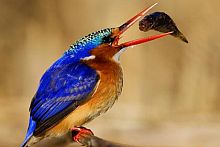Are protected areas effective in conserving biodiversity?
|
The simple answer is yes, of course - protected areas form the cornerstone of the global strategy towards the conservation of biodiversity.
Yet the ecological performance of protected areas - namely the representation and maintenance of key biodiversity features within reserves — remains poorly understood. For example, alarming evidence from large mammals suggests general population declines within protected areas across the African continent1, and the reasons for this are not yet clear.
As part of my PhD research, this issue is currently being addressed in collaboration with the SAEON Ndlovu Node in Phalaborwa. A component of the research compares bird assemblages inside Kruger National Park to bird assemblages in rural, urban and unprotected land use areas outside the Park.
There are not many studies available that have formally contrasted the occurrence of biodiversity features within and outside of individual protected areas. This two-year study is expected to reveal how bird diversity is reduced in the absence of a protected area.
The study will also document the functional diversity changes of birds across different land use areas. Functional diversity refers to what organisms do in ecosystems rather than the identity of a species, and so documents the role they play in maintaining the functioning of an ecosystem.
For more information contact Bernard W.T. Coetzee
1 Craigie I., Baillie J., Balmford A., Carbone C., Collen B. & Green J.B. (In press) Large mammal population declines in Africa's protected areas





